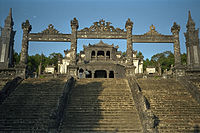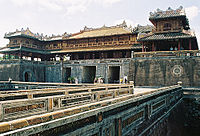- Imperial City, Huế
-
Complex of Huế Monuments * UNESCO World Heritage Site
Country Vietnam Type Cultural Criteria iv Reference 678 Region ** Asia-Pacific Inscription history Inscription 1993 (17th Session) * Name as inscribed on World Heritage List
** Region as classified by UNESCOThe Imperial City (Vietnamese: Kinh thành Huế) in Huế is a walled fortress and palace in the former capital of Vietnam.
Contents
Characteristics
The grounds of the Imperial City were surrounded by a wall 2 kilometers by 2 kilometers, and the walls were surrounded by a moat. The water from the moat was taken from the Huong River (Perfume River) that flows through Huế. This structure is called the citadel.
Inside the citadel was the Imperial City, with a perimeter of almost 2.5 kilometers.
Inside the Imperial City was the imperial enclosure called the Purple Forbidden City in Vietnamese, a term similar to the Forbidden City in Beijing. The enclosure was reserved for the Nguyen imperial family.
History
In June 1802 Nguyễn Phúc Ánh took control of Vietnam and proclaimed himself Emperor Gia Long. His rule was recognized by China in 1804.
Gia Long confided with geomancers to decide which was the best place for a new palace and citadel to be built. After the geomancers had decided on a suitable site in Huế, in 1804 building began. Thousands of workers were ordered to produce a wall and moat, 10 kilometer long. Initially the walls were earthen, but later these earthen walls were replaced by stone walls, 2 meters thick.
The citadel was oriented to face the Huong River to the east. This was different from the Forbidden City in Beijing, which faces south. The Emperor's palace is on the east side of the citadel, nearest the river. A second set of walls and a second moat was constructed around the Emperor's palace. Many more palaces and gates and courtyards and gardens were subsequently added.
The rule of the last Vietnamese Emperor lasted until the mid-1900s. At that time, the Purple Forbidden City had many buildings and hundreds of rooms. It suffered from termite and cyclone damage, but was still very impressive. Many bullet holes left over from the war can be observed on the stone walls.
The American bombing in 1968 in response to a communist takeover of Huế flattened most of the Imperial city. Only a few buildings survived, such as the Thai Hoa Temple, Can Thanh Temple, The Mieu, and Hieu Lam Cac.
The city was made a UNESCO site in 1993. The buildings that still remain are being restored and preserved. Unfortunately, most of the buildings were destroyed during the Vietnam War.
During the past few years, most of the destroyed buildings have already been reconstructed by the cooperation of the Vietnamese government, UNESCO, and other organizations.
Layout
Imperial City Gates
- Cửa Đông Nam (Southeast Gate), also called cửa Thượng Tứ
- Cửa Chính Đông also called cửa Đông Ba
- Cửa Đông Bắc (Northeast Gate) also called cửa Trài or cửa Mang Cá nhỏ
- Cửa Chính Bắc (cửa Hậu/cửa Mang Cá lớn)
- Cửa Tây Bắc (Northwest Gate) also called cửa An Hòa
- Cửa Chính Tây (cửa Chánh Tây)
- Cửa Tây Nam (Northwest Gate) also called cửa Hữu
- Cửa Chính Nam (cửa Nhà Đồ)
- Cửa Quảng Đức (cửa Sập)
- Cửa Thể Nhân (cửa Ngăn)
Forbidden City Main Gates
- Cửa Ngọ Môn
- Cửa Hòa Bình
- Cửa Chương Đức
- Cửa Hiển Nhơn
Temples and Places of Worship (KHU CAC VỰC MIẾU THỜ)
- Triệu Miếu
- Thái Miếu
- Hưng Miếu
- Thế Miếu
- Điện Phụng Tiên
Buildings
Cung Dien tho
Diên Thọ chính điện. Tịnh Minh Lâu Trường Du tạ Lương Phong đình Khương Ninh Các Tả trà Điện Thọ Ninh Bình phong tiền và hậu Cổng Thọ Chỉ, Thiện Khánh, Diễn Trạch và Địch Tường...
Gallery
-
The Imperial City's plan in Đại Nam nhất thống chí
References
Gia Long Events 


Wives Tong Thi Lan · Tran Thi Dang · Le Ngoc BinhFamily Capital works French supporters French assistance to Nguyễn Ánh · Pigneau de Behaine · Jean-Baptiste Chaigneau · Philippe Vannier · Jean-Marie Dayot · Olivier de Puymanel · Théodore LebrunVietnamese mandarins Chau Van Tiep · Do Thanh Nhon · Le Van Duyet · Nguyen Van Thanh · Nguyen Van Tuong · Truong Tan Buu · Vo Duy Nguy · Vo TanhCategories:
Wikimedia Foundation. 2010.








